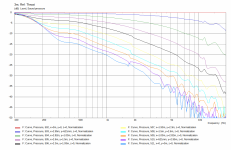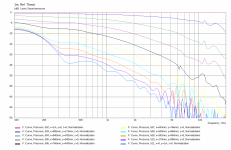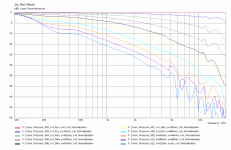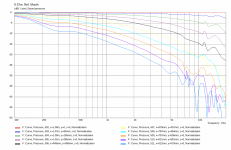I concur. The distance and point of rotation matters a lot. Whenever I measure my horns/waveguides at home with too small distances (~1m) I find that the horn is much wider than the simulation predicts (most recently a large +-50 degree horn I made showed closer to +-70 degree beamwidth at this distance and with wrong axis of rotation at the throat instead of the mouth). When taking the horn to a large space where measurements can be done at, say, 3m distance and with the same point of rotation as the AKABAK sim, they match almost perfectly. I typically set the mouth as the reference rather than the throat, FWIW.
Apologies; I guess I could've figured that out if I had paid attention to the polar map...The steps are 5°
I agree that the discrepancy is likely due to differences in distance and axis of rotation. If the profile is available, I can run a sim with these parameters matching the actual measurement conditions (or someone else can, if they're so inclined).
... is not the same as 5 deg steps - right!?...text is stated 5 degrees normalized.
//
Thanks. The origin of the rotation was on the Z-axis aligned with the horn mouth and I rotated the horn, with the mic at a fixed place. So the driver moved away sidewards in 10 degrees steps, I did not "obviously" rotated the mic. I understand mic distances matter, though. If I recall correctly, I used 1 meter distance from driver. I'll make some new measurements in free field then, with bigger mic distances. I won't bug you anymore, I conclude that matching a simulation with actual measurements may be more complicated than I realized, if you do not exactly know what parameters are used or how the rotation takes place. Unusable is a subjective qualification indeed. Depends on what you want to achieve.The steps are 5°, but for these small mic distances the actual mic position is quite dependent on the axis of rotation. My 20° can easily be Horneydude's 40°, as he obviously rotated the mic around the mouth. In the sims the origin is at the throat by default (which I believe was also the case here) with the mic farther away.
Walking, with closed eyes, around a speaker sending pink noise is quite revealing I would say... it's a good exercise I think...
//
//
That is a very kind offer, but I think it is not worth the effort as I am generally happy with the horn after all. The off axis peak at 10kHz is more problematic but I listen on-axis with threated sidewalls so I don't notice it, but it is noticable at certain places outside of the listening area.If the profile is available, I can run a sim with these parameters matching the actual measurement conditions
So thanks everyone for the input!
Is there any distortion measurements of the 4554+ adapter ? A friend of mine doesn’t think that it can be crossed at 6-700hz
This is all I have (it's not the final version) -
I don't have an equipment capable of any meaningful absolute values, so it's all FWIW. I can only say that I don't hear any distortion, which can mean many things... 🙂
BMS 4554 extended, with an adapter starting right at the exit of the (ring) diaphragm, which is roughly ⌀16 mm.
Still keeping the directivity of Gen2, I think this is actually pretty cool.
Shaping the response is no issue with a DSP. Perhaps it could be further optimized in the adpater, hard to say.


(Measured with A520G2; at two different distances from the mouth.)

- Did a quick sweep for harmonics, at two different levels, just to have an idea:
2nd, 3rd, 4th:



Seems to me like 700 Hz would still be no...
Still keeping the directivity of Gen2, I think this is actually pretty cool.
Shaping the response is no issue with a DSP. Perhaps it could be further optimized in the adpater, hard to say.
(Measured with A520G2; at two different distances from the mouth.)
- Did a quick sweep for harmonics, at two different levels, just to have an idea:
2nd, 3rd, 4th:
Seems to me like 700 Hz would still be no...
I don't have an equipment capable of any meaningful absolute values, so it's all FWIW. I can only say that I don't hear any distortion, which can mean many things... 🙂
It could be square I guess but intuitively, it's probably better to make it just a bit rectangular.Could it be made square to prevent a 'pattern flip" or does the equal size of the horizontal and vertical dimensions cause a problem and, consequently a rectangle is preferred?
This is the current "dev version 0", BTW (306 x 252 mm, maybe too deep):
thanks i really appreciate it mabat.This is all I have (it's not the final version) -
BMS 4554 extended, with an adapter starting right at the exit of the (ring) diaphragm, which is roughly ⌀16 mm.
Still keeping the directivity of Gen2, I think this is actually pretty cool.
Shaping the response is no issue with a DSP. Perhaps it could be further optimized in the adpater, hard to say.


(Measured with A520G2; at two different distances from the mouth.)

- Did a quick sweep for harmonics, at two different levels, just to have an idea:
2nd, 3rd, 4th:



Seems to me like 700 Hz would still be no...
I don't have an equipment capable of any meaningful absolute values, so it's all FWIW. I can only say that I don't hear any distortion, which can mean many things... 🙂
That MEH Synergy horn experience🙂Walking, with closed eyes, around a speaker sending pink noise is quite revealing I would say... it's a good exercise I think...
What were the distances? Listening distance 2 to 2.5 meters? or 40mm and 400mm? Horns can take a little time of flight for the wavefront to generate fully. Ideally we are talking soap bubbles yes? once the soap bubble leaves the ring it is fully formed. But in our case there are thousands of them a second, and they create an air pressure front that takes time to integrate into the room. Time means distance from the horn mouth. I understand the ideas behind presenting beautiful graphs. But real world distances can be just as useful. If we know the gating, we can understand the lower limit of where the graph is reliable.(Measured with A520G2; at two different distances from the mouth.)
Around 1 m. Once you're more than say 0.5 m away, the frequency responses virtually don't change further, and that's what I present. This can be shown both in simulations and real world. This is simply how high-quality devices behave.What were the distances?
I won't take this as an insult only because you obviously don't have enough experience with high-quality horns 😉I understand the ideas behind presenting beautiful graphs.
Last edited:
This is with ~5 ms window, the lower resonance will be a bit sharper in reality, that's to be expected.
Raw and EQed:


https://www.at-horns.eu/gen2-4554.html#measurements
These are not just nice pictures but honestly one of the best and most natural sounding devices I've ever heard.
If I was to choose one, this would be it. No matter if crossed at 500, 600 or 700 Hz, it still sounds very good.
Raw and EQed:
https://www.at-horns.eu/gen2-4554.html#measurements
These are not just nice pictures but honestly one of the best and most natural sounding devices I've ever heard.
If I was to choose one, this would be it. No matter if crossed at 500, 600 or 700 Hz, it still sounds very good.
Never even crossed my mind that it should be an insult. You are doing world class work here. I am learning. Yup I am learning a lot. Different ways of making them, different ideas. I appreciate all of this stuff.I won't take this as an insult only because you obviously don't have enough experience with high-quality horns 😉
Count me in on that one. I have to set up a totally horn loaded system. The main problem is I enjoy Organ music at concert levels. 😉These are not just nice pictures but honestly one of the best and most natural sounding devices I've ever heard.
If I was to choose one, this would be it. No matter if crossed at 500, 600 or 700 Hz, it still sounds very good.
This,,, I can see why that could be interpreted as a bit offensive... like "... just beautiful graphs..."...I understand the ideas behind presenting beautiful graphs.
//
True. Was never meant that way. I work with loudspeakers regularly. It is a big part of my income and my work. I see graphs pretty much daily and I know that there are real ones and pretty ones. There are many ways to game the graphs. And a lot of graphs online are pretties up a lot. Everyone here that has experience in acoustics knows this.This,,, I can see why that could be interpreted as a bit offensive... like "... just beautiful graphs..."...
When I typed that I learn a lot in this thread I am sincere about it. I am fairly well read and a designer of drivers and systems that gets called to fix FUBAR's of other engineers fairly regularly. I know some stuff. I certainly do not know everything there is to know about horns even though I have been designing them since 1993. I still see areas where my knowledge is lacking, or have repeated mistakes over and over. This thread has shown me a few things I have never considered before. Yourself and mabat included. There are others, but I am a championship name forgeter.
any chance for a second line of none-deep versions? (from 60-65 deg) while it is correct what @Zvu says, that many high quality rectangular waveguides left the market, at least, some can still be bought. for shallow waveguides there was barely any option ever at all.(306 x 252 mm, maybe too deep)
Well, I was curious so here's some data anyway. I used Hornresp to calculate a profile that hopefully isn't too far off (265Hz; T=0.71; "Exact Profile" selected on export), then used ABEC3 for the simulation.That is a very kind offer, but I think it is not worth the effort
Attachments
- Home
- Loudspeakers
- Multi-Way
- Acoustic Horn Design – The Easy Way (Ath4)



